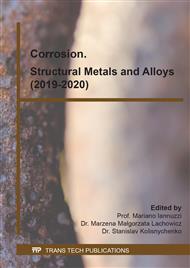p.509
p.515
p.521
p.527
p.535
p.541
p.547
p.555
p.563
Liquid Metal Embrittlement of Copper Brazed Plate Heat Exchangers
Abstract:
Plate heat exchangers are widely used for heating and cooling activities in domestic and industrial applications. The plates of all these components were made of stainless steel (e.g. type X2 CrNiMo 17-12-2) and they were brazed with pure copper. After cutting and metallographic preparation, the samples were investigated by light optical microscopy (LOM) to measure the depth of copper penetration into the plates (liquid metal embrittlement (LME)). For seven heat exchangers the penetration depth was between 25 and 60 μm, but for one the depth was about 150 μm. At the steel-copper interfaces an additional phase was identified as chromium-rich ferrite by electron beam micro analysis (EBMA). To get information about the sensitivity against corrosion electrochemical tests were performed in two electrolytes (HCO3- + SO42- and HCO3- + SO42- + Cl-). It can be summarized that in the Cl- free electrolyte the copper was attacked mainly. In case of the Cl- containing electrolyte beside the copper braze, the LME zones in the steel were corroded additionally.
Info:
Periodical:
Pages:
535-540
Citation:
Online since:
June 2019
Authors:
Price:
Сopyright:
© 2019 Trans Tech Publications Ltd. All Rights Reserved
Share:
Citation:



